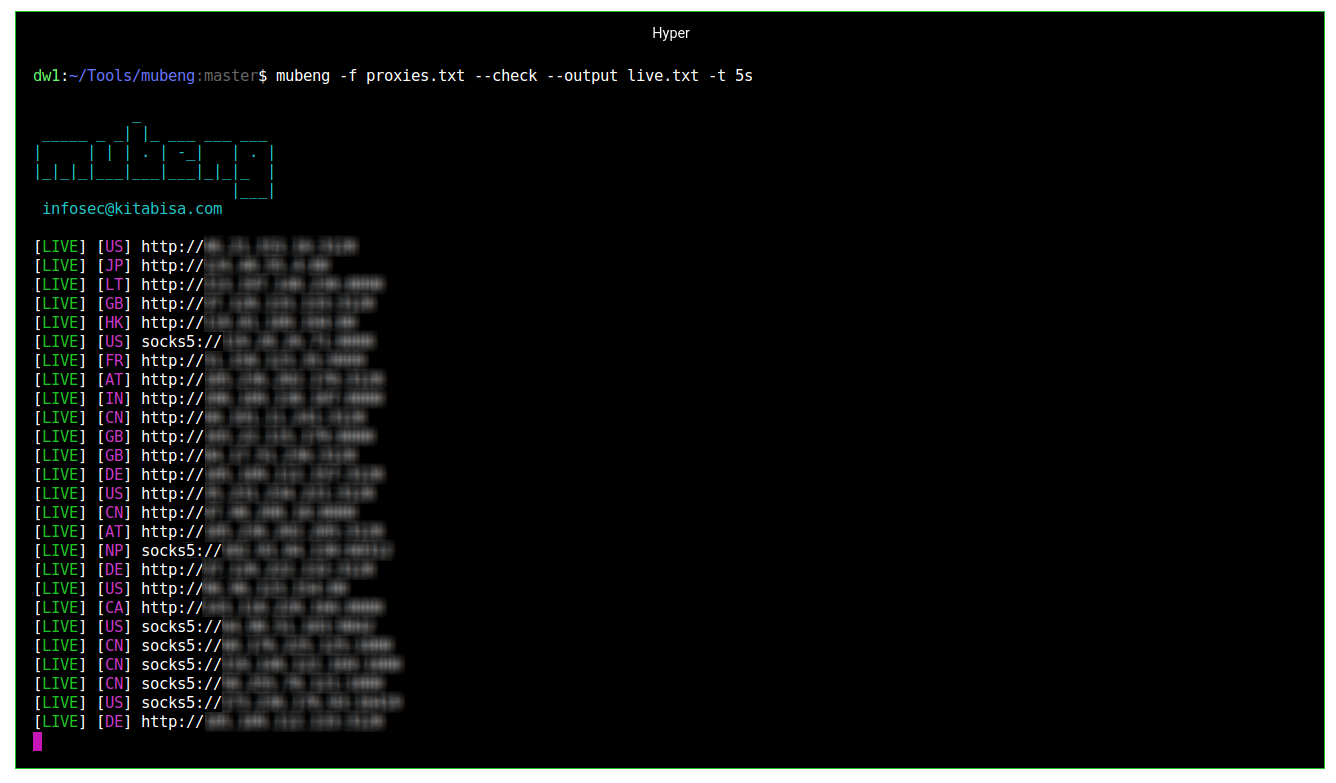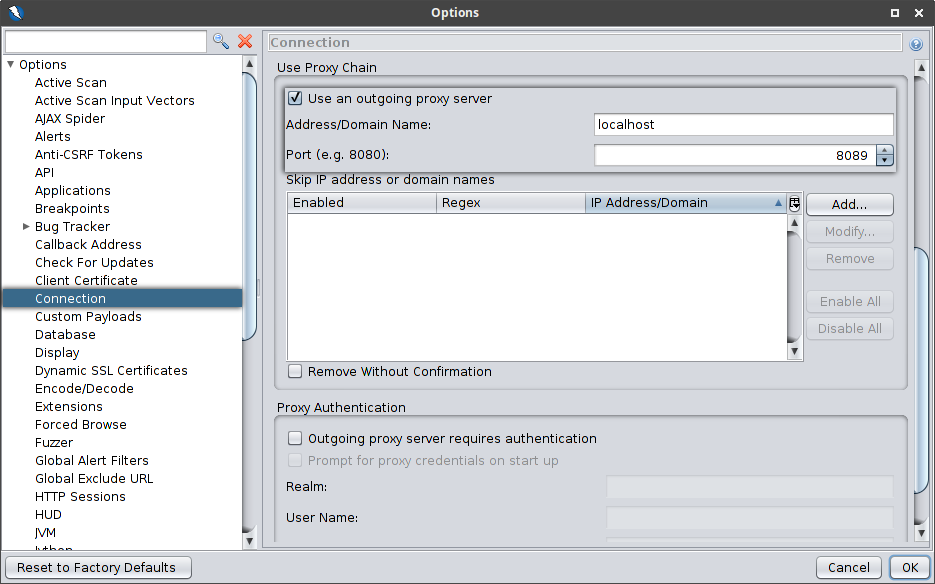
An incredibly fast proxy checker & IP rotator with ease. Modified by Vay3t, Original repo: https://github.com/kitabisa/mubeng


Features
- Proxy IP rotator: Rotates your IP address for every specific request.
- Proxy checker: Check your proxy IP which is still alive.
- All HTTP/S methods are supported.
- HTTP, SOCKS v4(A) & v5 proxy protocols apply.
- All parameters & URIs are passed.
- Easy to use: You can just run it against your proxy file, and choose the action you want!
- Cross-platform: whether you are Windows, Linux, Mac, or even Raspberry Pi, you can run it very well.
Why mubeng?
It's fairly simple, there is no need for additional configuration.
mubeng has 2 core functionality:
1. Run proxy server as proxy IP rotation
This is useful to avoid different kinds of IP ban, i.e. bruteforce protection, API rate-limiting or WAF blocking based on IP. We also leave it entirely up to user to use proxy pool resources from anywhere.
So, you don't need any extra proxy checking tools out there if you want to check your proxy pool.
Modified
Notes
A fork of version 0.10.0 was made and modified so that it could be compiled with Golang 1.18 and locally. More information: https://github.com/kitabisa/mubeng/issues/88
Installation
Binary
Simply, download a pre-built binary from releases page and run!
Source
Using Go (v1.18+) compiler:
go install gitlab.com/vay3t/mubeng/cmd/mubeng@latest
| NOTE: The same command above also works for updating. |
Usage
For usage, it's always required to provide your proxy list, whether it is used to check or as a proxy pool for your proxy IP rotation.

Basic
mubeng [-c|-a :8080] -f file.txt [options...]
Options
Here are all the options it supports.
mubeng -h
| Flag |
Description |
-f, --file <FILE> |
Proxy file. |
-a, --address <ADDR>:<PORT> |
Run proxy server. |
-A, --auth <USER>:<PASS> |
Set authorization for proxy server. |
| -d, --daemon |
Daemonize proxy server. |
| -c, --check |
To perform proxy live check. |
--only-cc <AA>,<BB> |
Only show specific country code (comma separated). |
| -t, --timeout |
Max. time allowed for proxy server/check (default: 30s). |
-r, --rotate <AFTER> |
Rotate proxy IP for every AFTER request (default: 1). |
-m, --method <METHOD> |
Rotation method (sequent/random) (default: sequent). |
| -s, --sync |
Sync will wait for the previous request to complete. |
| -v, --verbose |
Dump HTTP request/responses or show died proxy on check. |
| -o, --output |
Save output from proxy server or live check. |
| -u, --update |
Update mubeng to the latest stable version. |
| -w, --watch |
Watch proxy file, live-reload from changes. |
| -V, --version |
Show current mubeng version. |
NOTES:
- Rotations are counted for all requests, even if the request fails.
- The proxy server runs asynchronously by default, so it doesn't guarantee that your requests after N (which is N+1 and so on) will rotate the proxy IP, instead use the
-s/--sync flag to wait for requests to the previous proxy to complete.
- Daemon mode
(-d/--daemon) will install mubeng as a service on the (Linux/OSX) system/setting up callback (Windows).
- Hence you can control service with
journalctl, service or net (for Windows) command to start/stop proxy server.
- Whenever you activate the daemon mode, it works by forcibly stop and uninstalling the existing mubeng service, then re-install and starting it up in daemon.
- Verbose mode
(-v/--verbose) and timeout (-t/--timeout) apply to both proxy check and proxy IP rotation actions.
- HTTP traffic requests and responses is displayed when verbose mode
(-v/--verbose) is enabled, but
- We DO NOT explicitly display the request/response body, and
- All cookie values in headers will be redacted automatically.
- If you use output option
(-o/--output) to run proxy IP rotator, request/response headers are NOT written to the log file.
- A timeout option
(-t/--timeout) value is a possibly signed sequence of decimal numbers, each with optional fraction and a unit suffix, such as "5s", "300ms", "-1.5h" or "2h45m".
- Valid time units are "ns", "us" (or "µs"), "ms", "s", "m", and "h".
|
Install SSL Certificate
mubeng uses built-in certificate authority by GoProxy. With mubeng proxy server running, the generated certificate can be exported by visiting http://mubeng/cert in a browser.
Installation steps for CA certificate is similar to other proxy tools.
Examples
For example, you've proxy pool (proxies.txt) as:
http://127.0.0.1:8080
socks4://127.0.0.1:4145
socks5://127.0.0.1:2121
...
...
|
Proxy checker
Pass --check flag in command to perform proxy checks:
mubeng -f proxies.txt --check --only-cc AU,US,UK --output live.txt
The above case also uses --output flag to save a live proxy of specific country code with --only-cc flag (ISO-3166 alpha-2) into file (live.txt) from checking result.
 (Figure: Checking proxies mubeng with max. 5s timeout)
(Figure: Checking proxies mubeng with max. 5s timeout)
Proxy IP rotator
Furthermore, if you wish to do proxy IP rotator from proxies that are still alive earlier from the results of checking (live.txt) (or if you have your own list), you must use -a (--address) flag instead to run proxy server:
▶ mubeng -a localhost:8089 -f live.txt -r 10 -m random
The -r (--rotate) flag works to rotate your IP for every N request value you provide (10), and the -m (--method) flag will rotate the proxy sequential/randomly.
 (Figure: Running mubeng as proxy IP rotator with verbose mode)
(Figure: Running mubeng as proxy IP rotator with verbose mode)
In case you want to use mubeng (proxy IP rotator) as an upstream proxy in Burp Suite, acting in-between Burp Suite and mubeng to the internet, so you don't need any additional extensions in Burp Suite for that. To demonstrate this:
 (Figure: Settings Burp Suite Upstream Proxy to mubeng)
(Figure: Settings Burp Suite Upstream Proxy to mubeng)
In your Burp Suite instance, select Project options menu, and click Connections tab. In the Upstream Proxy Servers section, check Override user options then press Add button to add your upstream proxy rule. After that, fill required columns (Destination host, Proxy host & Proxy port) with correct details. Click OK to save settings.
It acts the same way when you using an upstream proxy. OWASP ZAP allows you to connect to another proxy for outgoing connections in OWASP ZAP session. To chain it with a mubeng proxy server:
 (Figure: Settings proxy chain connection in OWASP ZAP to mubeng)
(Figure: Settings proxy chain connection in OWASP ZAP to mubeng)
Select Tools in the menu bar in your ZAP session window, then select the Options (shortcut: Ctrl+Alt+O) submenu, and go to Connection section. In that window, scroll to Use proxy chain part then check Use an outgoing proxy server. After that, fill required columns (Address/Domain Name & Port) with correct details. Click OK to save settings.
Limitations
Currently IP rotation runs the proxy server only as an HTTP protocol, not a SOCKSv4/v5 protocol, even though the resource you have is SOCKSv4/v5. In other words, the SOCKSv4/v5 resource that you provide is used properly because it uses auto-switch transport on the client, but this proxy server DOES NOT switch to anything other than HTTP protocol.
Contributors
Pronunciation
jv_ID • /mo͞oˌbēNG/ — mubeng-mubeng nganti mumet. (ꦩꦸꦧꦺꦁꦔꦤ꧀ꦠꦶꦩꦸꦩꦺꦠ꧀)
Changes
For changes, see CHANGELOG.md.
License
This program is free software: you can redistribute it and/or modify it under the terms of the Apache license. Kitabisa mubeng and any contributions are Copyright © by Dwi Siswanto 2021.